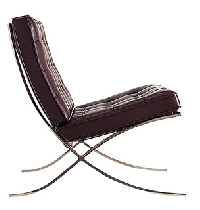
Exploring who influenced modern furniture design is an interesting journey
Avante-garde means that it was experimental and innovative. And, modern furniture was and still is.
In the first part of the 20th century there was a strong emphasis toward moving away from furniture that was ornamental to furniture that was functional, comfortable and accessible. As this transition took place, furniture metamorphosed from being and looking very heavy and foreboding to becoming visually light and airy as well as a lot lighter physically than its predecessors.
Prior to the movement toward modern furniture, the typical household furniture was ornate and featured gilded wood and fabrics that were quite rich and expensive.
So who influenced modern furniture design? There were artists, designers, and of course, the people who purchased and appreciated the “new” modern furniture.
Before the birth of “modern furniture,” artisans worked to maintain the traditions of the past both in architectural design and furniture. All that changed when social philosophy shifted and the emphasis turned to espousing new ideas and fresh shapes and forms. As the methods of producing furniture advanced and new materials were introduced into the fray, the preference in furniture designs, as well as in lifestyles, changed and this led to a simpler, more streamlined look.
~
The advent of modern furniture shared the stage with the new way of practicality as opposed to the oppressive customs of the past. There was a yearning for autonomy and free thinking that was not present in the past. The modern furniture reflected this innovative way of thinking and living.
Bauhaus and Walter Gropius
The Bauhaus school in Germany was in operation from 1919 and 1933 and significantly influenced furniture design. This school taught both the fine arts and crafts and was founded by Walter Gropius. This school along with Werkbund, which was a German organization for architects, artists, industrial tradesmen and designers, founded in 1907, also had an influence on furniture design.
Other influences
Other than Gropius, with the staff and students at the Bauhaus School, and the influential people at Werkbund, a single person cannot be pinpointed as spurring on the modernist movement. It is believed that modernism was an outcome of various factors including new ways of manufacturing items and the discovery of new materials that had never been used before.
The Art Nouveau period had an influence on furniture design. The new art era started in the late 1800s and ran through the first decade of the 20th century. Art Nouveau embraced a fresh way of thinking in addition to producing art that had never been seen before.
New-fangled production methods were used and everything, even the most mundane and ordinary piece object, was considered a potential piece of art. The artists in this era were versatile. In addition to painting they designed furniture, which resulted in furniture becoming a functional piece of art that was a part of every day life. The creations were a mix of harmony and beauty, which made life easier and better, along with more beautiful.
Mies van der Rohe
The primary pieces of furniture that have become iconic from the modern classical era are the Barcelona chair and ottoman, which were designed for the Barcelona World Fair in 1929. It was the brainstorm of Mies van der Rohe of Bauhaus and Lilly Reich, the architect and designer. The frame of this chair is stainless steel. It is reproduced to this day and is considered a highly prized piece of furniture as well the gold standard for modern furniture.
The use of steel rather than gilded wood became popular during the modern era. Additionally, molded plywood was used and various types of plastic. The goal for furniture designs was to create the perfect balance between practicality and beauty. The pieces were easily manipulated and consisted of novel textures, colors and shape.
When the shape and function of furniture changed, this altered the organization of rooms. Modern furniture is often multi-functional and can be used for more than one purpose. The colors of the Art Deco era went the way of avocado refrigerators in the 1970s and the lovers of modernism chose to decorate using blacks and grays complemented by chartreuse, ruby red, turquoise and tangerine. Chrome, acrylic and other metals and materials are incorporated into the modern room, which creates a very out of the ordinary look.
